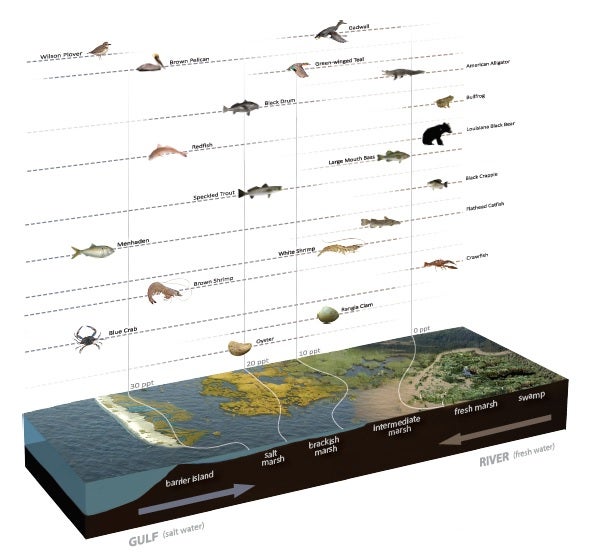Estuaries 102: Louisiana Estuaries & Restoration
This is part two of our National Estuaries Week blog! See part one here. Learn more about events in your area and other ways to get involved at www.estuaries.org/national-estuaries-week.
There are lots of wetlands in the United States – more than 110 million acres! With so many wetlands, why do we focus so much on coastal wetlands and estuaries?
In our previous post, we discussed how important estuaries are to wildlife and humans, despite the fact that estuarine and marine wetlands make up only 5 percent of all wetlands in the lower 48.
Even though coastal wetlands are a relatively small proportion, they are vitally important to ecological and economic production because of the diverse habitats and many ecosystem services they provide. Because of this, it is even more important that we restore and conserve these ecosystems and their natural resources.
What makes Louisiana estuaries so unique?
The Mississippi River watershed is the 4th largest watershed in the world! The river brings fresh water, sediment and nutrients from 40 percent of the continental U.S. to a relatively small area – approximately 4,000 square miles. Not only has the river created Louisiana’s wetlands over thousands of years, but the inputs from the river help make Louisiana’s estuaries productive and diverse.
The Mississippi River watershed drains over 1.2 million square miles of the United States. Credit: NASA
Louisiana is home to the largest area of high-density coastal wetlands in the country – meaning, there is a lot of wetland area throughout the coast. Something every Louisianian already knows! This high concentration of estuarine wetlands is the engine behind our ever-productive fisheries. Louisiana is the top shrimp-producing state in the U.S. and supplies more than one-third of America’s oysters. This would not be possible without our estuaries.
Unfortunately, Louisiana estuaries – as with coastal areas across the globe – are under threat. When there are interruptions or changes to the dynamics that make estuaries so productive, there can be negative effects to the ecosystem as well.
Sea level rise, coastal erosion, and changes in freshwater flows caused by natural or man-made variations are all threats to the health and productivity of estuarine ecosystems and habitats.
What can be done to help restore estuaries?
There is no one thing you can do to restore estuaries, because they are dynamic ecosystems defined and determined by gradients.
However, one of the most important things that can be done is to restore what scientists call “natural ecosystem processes.” A natural ecosystem process is a cycle or a series of changes that happens in an ecosystem, keeping it within a dynamic equilibrium where there is some change but not too much. These processes will often connect different parts of the ecosystem, such as water, nutrients and plants.
Because salinity is one of the most important factors in an estuary because salinity gradients create different types of estuarine habitat, freshwater inputs or flows to an estuary are very important. Unfortunately, the natural flow of fresh water to many of Louisiana’s estuaries has been changed by the construction of river levees and other infrastructure.

Many different fish and wildlife species are found throughout Louisiana’s estuaries. Dashed line indicates the general range of salinity and habitats where each species might be found. Credit: Coalition to Restore Coastal Louisiana, LSU Coastal Sustainability Studio
In some areas, restoring freshwater flows can be as simple as installing culverts under a road or breaking through sections of a spoil bank along a man-made canal. In others, it will require construction of large water-control structures, like sediment diversions, to allow fresh water and sediment to flow from the river into surrounding wetlands.
Restoring natural ecosystem processes will restore certain kinds of habitat – but over long periods. In addition to restoring natural ecosystem processes, there are specific features found in Louisiana’s estuaries that also need to be restored because they provide important habitat and ecosystem services.
Coastal ridges and barrier islands, for example, provide places to live, eat and reproduce for the 100 million birds that live in or pass through the Mississippi River Delta each year. They also play a role in reducing wave energy and storm surge, which helps protect our communities and other built infrastructure.
As we celebrate the Mississippi River Delta and other estuaries this week, take action and tell the RESTORE Council to prioritize large-scale restoration in their comprehensive plan update.
Estelle Robichaux leads Restore the Mississippi River Delta’s project-related efforts, including those focused on science-based decision-making processes, project implementation and other related research. In this role, Estelle advocates for the implementation of science-based restoration projects and programs in coastal Louisiana. Estelle’s work also focuses on science communication and monitoring the development of scientific and research programs related to coastal Louisiana in the wake of the Gulf oil disaster.